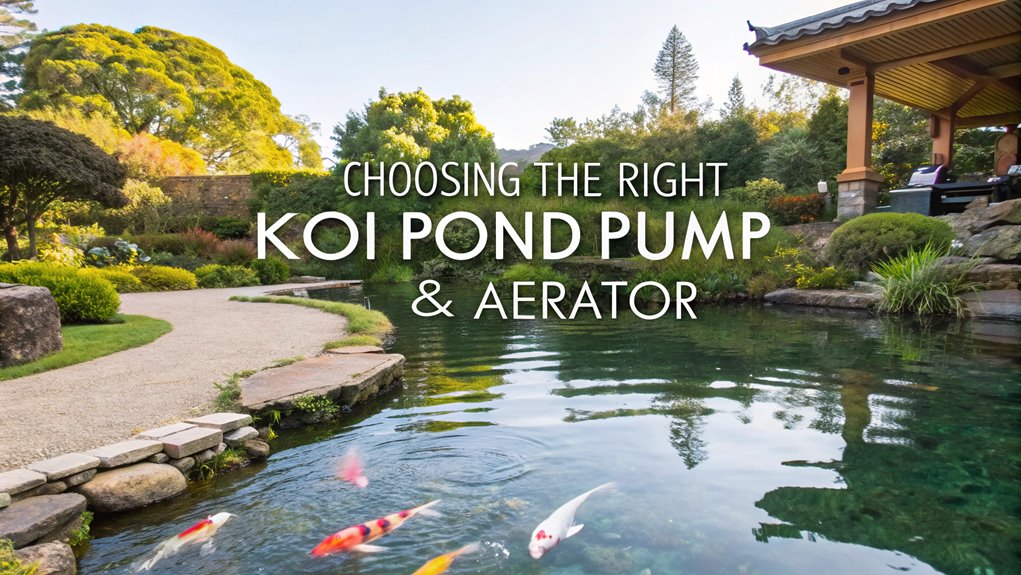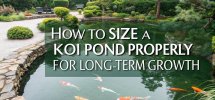When selecting the right koi pond pump and aerator, start by evaluating your pond’s size and depth to guarantee ideal oxygenation and pump efficiency. Choose between submersible or external pumps based on pond dimensions, and consider flow rate and head height for energy efficiency. Look for pumps with adjustable flow rates and noise levels under 50 decibels. Prioritize durable materials for longevity, and consult experts for tailored solutions. Explore further to enhance your koi pond’s environment effectively.
TLDR
- Evaluate pond size, depth, and shape to select appropriately sized pumps and aerators for effective oxygen distribution.
- Consider submersible pumps for smaller ponds and external pumps for larger systems requiring more power and efficiency.
- Ensure pump flow rate circulates pond volume every two hours, considering head height for optimal performance.
- Opt for energy-efficient models with adjustable flow rates, reducing power consumption and operational costs.
- Consult professionals for expert assessments tailored to specific pond needs, ensuring suitable pump and aerator selection.
Understanding the Importance of Aeration in Koi Ponds
When you’re maintaining a koi pond, understanding the importance of aeration can’t be overstated. Aeration is essential, as it guarantees oxygen levels are sufficient for koi health, directly affecting their growth and well-being.
By providing adequate oxygen, you’re supporting beneficial bacteria that break down organic waste, enhancing water quality and preventing harmful toxins like ammonia and nitrites. Poor aeration leads to problems like fish gasping, murky water, and excessive algae growth, all of which disrupt the pond’s ecosystem.
Furthermore, in larger pond sizes, maintaining oxygenation is crucial to avoid stagnation, especially in deeper areas. Effective aeration not only promotes water clarity but also reduces risks of pests and pathogens, safeguarding your koi and maintaining a healthy aquatic environment.
Evaluating Pond Size and Depth for Optimal Aeration
Understanding the pond’s dimensions is key to guaranteeing ideal aeration for your koi. Accurately measure the pond’s length, width, and maximum depth to calculate the size using the formula: Pond Volume = (L x W x D x 7.48) ÷ 2. This helps determine the necessary pump and aeration system.
Aeration is essential for oxygenating water, especially if your pond exceeds 6-7 feet in depth. For deeper ponds, sub-surface aeration effectively oxygenates lower water layers, as surface fountains might fall short.
If your pond shape is irregular, consider multiple systems to guarantee even oxygen distribution. Select aeration kits based on the pond’s maximum depth to prevent compressor wear, guaranteeing ideal water quality and koi health.
Exploring Different Types of Koi Pond Pumps
Although selecting the right koi pond pump might seem challenging, understanding the options can simplify your decision.
Submersible pumps and external pumps are your primary choices. Submersible pumps are excellent for smaller koi ponds, offering easy installation and efficient water circulation directly within the pond.
External pumps, on the other hand, provide more power and energy efficiency, suitable for larger systems. Proper pump sizing is essential, as it should circulate the entire pond volume at least once every two hours to sustain water quality and oxygen levels.
Regular maintenance, such as cleaning and inspections, guarantees peak performance.
- Submersible pumps: Ideal for smaller ponds.
- External pumps: Best for larger systems.
- Proper pump sizing: Guarantees effective circulation.
- Water circulation: crucial for pond health.
- Maintenance: Extends pump life.
Comparing Floating Fountains and Pond Aerators
After selecting the right koi pond pump, it’s important to evaluate the roles of floating fountains and pond aerators in maintaining a healthy pond environment.
Floating fountains primarily enhance aesthetics with decorative displays, offering limited aeration suitable for already clean ponds. However, for proper aeration, pond aerators are vital. They move considerably more water, guaranteeing an oxygen-rich environment, essential for fish health and improved water quality.
In deeper ponds, over 6-7 feet, sub-surface aerators are preferred as floating fountains can’t effectively oxygenate lower layers. Combining a floating fountain with a sub-surface aerator achieves both visual appeal and functional benefits, promoting a balanced ecosystem.
Efficient stainless-steel motors and propellers in pond aerators guarantee peak performance and sustainability.
Considering Flow Rate and Head Height in Pump Selection
When selecting a koi pond pump, evaluating the flow rate and head height is crucial to guarantee ideal water circulation and oxygenation. Aim for a pump that can circulate the pond’s entire volume at least once every two hours to maintain water quality.
Consider head height, the vertical distance the water is pumped, to match it with the pump’s capacity. A higher head height demands a stronger pump to achieve the desired flow rate, guaranteeing efficient water circulation and energy efficiency.
Pumps often list flow rates and head heights, helping you align your pond’s requirements with the pump’s specifications.
- Confirm the flow rate meets or exceeds pond volume requirements.
- Consider head height for optimal pump performance.
- Balance flow rate and head height for energy efficiency.
- Check pump specifications for compatibility.
- Maintain water quality and oxygenation.
Assessing Energy Efficiency and Noise Levels
To maximize the efficiency and minimize the noise of your koi pond pump, understanding energy consumption and sound output is essential.
Evaluate energy efficiency by examining how many gallons per hour your pump moves per watt. Opt for models with adjustable flow rates; they let you tailor energy use and reduce power consumption when full capacity isn’t needed.
Consider noise levels: pumps rated below 50 decibels are ideal for minimizing disruption. Prioritize high-quality materials for durability, which enhances long-term energy efficiency.
Regular maintenance, such as cleaning and inspecting components, keeps your pump operating at peak performance levels. This not only extends the pump’s lifespan but also guarantees consistent efficiency, balancing operational costs and maintaining a serene pond environment.
Ensuring Durability and Ease of Maintenance
Understanding energy efficiency and noise levels sets the foundation for selecting a reliable koi pond pump, but guaranteeing durability and ease of maintenance is equally important for long-term performance.
Opt for pumps and air pumps constructed with high-quality materials, like stainless steel or UV-resistant plastics, to enhance durability and minimize wear.
Regular maintenance, such as cleaning filters and checking components, is crucial for peak performance. Models with easy-access features simplify these tasks, reducing downtime.
Energy-efficient options not only cut operational costs but also extend equipment lifespan by reducing motor strain.
Look for robust warranties covering parts and labor, safeguarding your investment in pond aeration.
- Choose high-quality materials
- Schedule regular maintenance
- Opt for easy-access features
- Select energy-efficient models
- Guarantee robust warranties
Tips for Installing and Maintaining Your Pump and Aerator
Installing and maintaining your koi pond pump and aerator requires precision and attention to detail to guarantee the health of your aquatic environment.
Ascertain the pump for your koi is properly sized, circulating the entire pond volume every two hours to maintain water quality. Follow manufacturer instructions meticulously: place submersible pumps on a flat surface in the deepest pond area, and position external pumps below water level for effective priming.
Regularly clean the pump and aeration systems, focusing on filters and air stones to prevent clogs. Implement seasonal adjustments by increasing aeration in summer and reducing in winter, which helps in maintaining ideal oxygen levels.
Use inline valves to control air distribution, adapting based on fish behavior and water conditions.
Strategies for Energy-Saving and Efficient Operation
Maintaining your koi pond’s pump and aerator doesn’t just guarantee a healthy aquatic environment—it also sets the stage for energy-efficient operation.
Opt for pumps with adjustable flow rates to tailor energy usage according to specific pond conditions and seasonal demands, effectively reducing operational costs. Energy-efficient motors designed for your pond’s size assure peak performance without overworking.
Implement timers to manage pump operation, guaranteeing adequate aeration during peak hours while conserving energy by lowering speeds at night. Regular maintenance prevents clogging, maintaining efficiency and energy savings.
If your pond features waterfalls or fountains, use separate pumps to distribute workload, minimizing the energy consumption of a single unit.
How Expert Advice Can Enhance Your Koi Pond Environment
When you seek expert advice for your koi pond, you’re guaranteeing a tailored approach that aligns perfectly with your pond’s unique needs.
Professionals assess your pond’s size, depth, and fish density, guiding you in choosing a pump and pond aerator that maximize oxygenated water and enhance pond equipment efficiency. Their insights allow for precise pond water management, guaranteeing your koi thrive.
Experts can recommend energy-efficient models, balancing performance with cost, and addressing unique characteristics like irregular shapes or multi-level designs for effective air circulation.
Additionally, they offer guidance on seasonal adjustments, maintaining stable conditions amid temperature changes. Staying informed about the latest technology in air pumps guarantees your investment promotes the well-being of your koi and ecosystem.
Frequently Asked Questions
How Do I Know What Size Aerator I Need for My Pond?
Calculate your pond’s volume using L x W x D x 7.48 ÷ 2. Choose an aerator circulating the pond’s volume every two hours. Consider depth, shape, and fish density, adjusting aerator size for ideal oxygenation and distribution.
What Size Aerator Pump Do I Need?
Imagine your pond as a living, breathing organism. You’ll calculate its lifeblood—the right aerator pump size—by evaluating volume, depth, and fish density. Verify your choice circulates water effectively, empowering your pond’s vibrant ecosystem.
What Size Air Pump for Koi Pond?
Calculate your koi pond’s total volume, then choose an air pump circulating that volume every two hours. For surface area, provide 1-2 liters per minute per square foot. Adjust for deeper ponds and higher fish densities.
Can You Have Too Much Aeration in a Koi Pond?
Imagine a koi pond as a bustling city. Too much aeration is like a chaotic traffic jam, stressing your koi and disrupting their routine. Balance oxygen levels by observing fish behavior, ensuring a harmonious aquatic environment.
Conclusion
In summary, choosing the right koi pond pump and aerator boils down to understanding your pond’s specific needs. Evaluate the pond size, depth, and desired flow rate while considering pump durability and maintenance ease. By comparing floating fountains and aerators, you can pinpoint the best fit. Remember, a well-chosen system is the heartbeat of your pond, ensuring energy efficiency and ideal aeration. Expert advice can be the cherry on top in enhancing your koi pond environment.


